Bayview Koala Sanctuary
At Mona Vale a farm of 40 acres known as the 'Zoo Farm’ produced feed for the creatures of Taronga Zoo. The farm was managed by Charlie Bishop with other workers including Stan Wenman and Brian Godwin. The land was purchased in 1947 by Sir Edward Hallstrom (1886-1970) solely for this purpose. A member of the Taronga Zoo Park Trust from 1941 to 1959, its president from 1948 to 1959 and honorary director until 1967, an animal lover from an early age, Mr Hallstrom thought the farm would ensure the animals in his keeping would have the fresh food they required.
The large section where Bayview Retirement Village now is was the site of the Koala Refuge created by Sir Edward Hallstrom, who died February 27th, 1970. A guest of the MWPHS in January 2014, John Bungey, Landscape Designer, was involved in the development of this site from 1975. John described his initial engagement by Tony Baldwin, a real estate developer on the North Shore, after the landscaper he had originally employed had been overwhelmed by the size of the project. The other important element in the creation of Bayview Gardens was the architect, Geoffrey Twybill, formerly of Waratah Street, Palm Beach (RIP), who had become a specialist in the design of retirement complexes.
John elaborated on the way the gardens were developed moving up the site and the creation of Annam Road which now encircles Bayview Gardens, although sections of this show up on earlier subdivision lithographs. In his Talk Mr. Bungey described the manner in which the native vegetation had been retained as much as possible, including such trees as Scribbly Gum, Swamp Mahogany and Angophora. The sheer scale of managing the various independent contractors on site, was not only due to Tony Baldwin, but also due to Noel Moss, the builder. The approximate time of development was 10 years and over time there were a number of awards earned by John and others involved in the development of the site.
While the focus of the talk was on Bayview Gardens, there were many questions from the audience as to the activities of Sir Edward Hallstrom. The zoo had been created as a forerunner to his involvement with Taronga Park Zoo which had commenced in 1937. Taronga Park itself opened in 1916 after the closing of Sydney’s first zoo at Moore Park. Sir Edward acquired the market garden and farmlet at Mona Vale/ Bayview in 1947 and this property functioned as a supplier of fodder to Taronga Park until 1975. [4.] Sir Hallstrom's land holdings in the present day industrial area of Mona Vale were all brought under the Real Property Act in the mid 1950's.
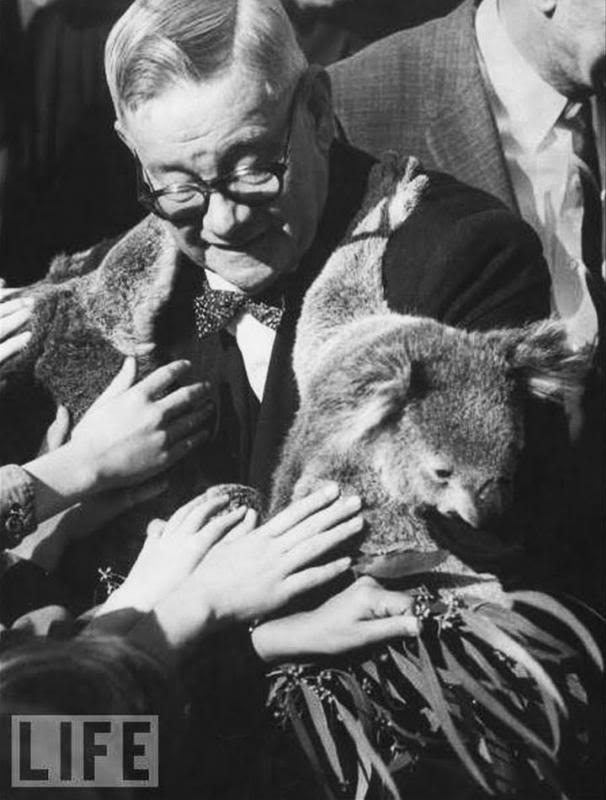
Overlooking Bayview Golf Course, with Annam Road and Beaumont Crescent as its perimeters, E J Hallstrom had a private zoo that came to be known as a Koala Sanctuary. On these acres Mr Hallstrom nursed koalas back to health and reintroduced them to their natural habitats. Mr Hallstrom also had one of the most extensive collections of birds, particularly parrots, and here too albino kangaroos from Tasmania and two sets of twin white wallabies were given a home. This was not his first venture in Pittwater. Edward Hallstrom was among those involved in helping George Taylor get airborne from North Narrabeen’s sand dunes in 1909.
It is for his many philanthropic works and large monetary donations to medical facilities that this gent is now known. He sought publicity for the plight of koalas and other animals incessantly. In the koala, adorable to look at even if a testy at times, he found a large crowd of instant and curious admirers. Most of those he cared for were given names, like pets. Stories regarding his Koala Sanctuary and those whom he introduced to the bear ran from the 1930’s until 1960.
Warringah Shire Records show:
19. Lands Department, 6/10/42, advising that the Department has received from Mr. E.J.L. Hallstrom an application for the purchase of part of a private subdivision road which runs into Cabbage Tree Road, requesting that the Council furnish particulars of the dedication of the road as a public road, and suggesting if no evidence of dedication is available, the Council consider taking action under the provisions of Section 224 of the Local Government Set to make the road a public road, after which it could be closed and sold under the Public Roads Act provided such a course is found to be unobjectionable in the public interest. Resolved, - That, as recommended by the Engineer, the Council object to the closing of the road, and that it take action under the provisions of Section 224 (3) of the Local Government Act to make the road a public road. (Crs. Baths, McLean)
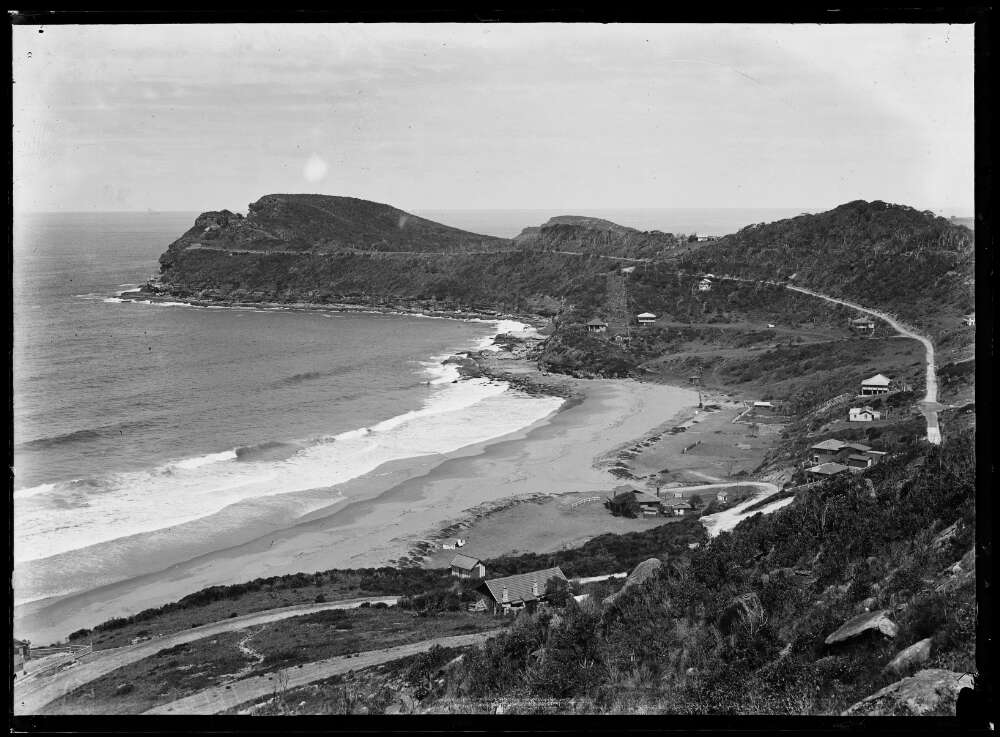
Koala Study Centre For N.S.W..
The Chief Secretary, Mr. C. H. Matthews, said last night that, the deputy chairman of the Fauna Protection Panel, Mr. E. J. Hallstrom, had offered to make his property at Mona Vale available for research into the conservation of koala bears. He said Mr Hallstrom would put up any buildings required and would provide labour for the care of the animals. He said that he and the panel appreciated Mr. Hallstrom's generosity. It was intended, to use the property as a centre for scientific investigation into the breeding, feeding, and diseases of koalas.
EXPERT ADVICE: The panel would-have the advice of experts, including Professor P.D. F. Murray, Challis Professor of Zoology at the University of Sydney. Mr. Matthews said the panel was making a State-wide survey to find out about-how many koalas there are. He appealed to the public to give the chief guardian of fauna. Mr. F.J. Griffiths, any information about the location of koala colonies in New South Wales Mr. Griffiths is in the Chief Secretary's. Department. Koala Study Centre For N.S.W. (1949, October 18). The Sydney Morning Herald (NSW : 1842 - 1954), p. 2. Retrieved August 11, 2012, from http://nla.gov.au/nla.news-article27577048
SAVING KOALA
The NSW Chief Secretary (Mr C. H. Matthews) said last week that the deputy chair-man of the Fauna Protection Panel (Mr E. J. Hallstrom) had offered to make his property at Mona Vale available for research into the conservation of koala bears.
He satd that Mr Hallstrom would put up any buildings required and would provide labour for the care of the animals. He and the panel appreciated Mr Hallstrom's generosity. It was intended to use the property as a centre for scientific investigation into the breeding, feeding, and diseases of koalas.
The panel would have the advice of experts, including Professor P. D. F. Murray, Challis Professor of Zoology at the University of Sydney.
Mr Matthews said the panel was making a State-wide survey to find out how many Koalas there are. He appealed to the public to give the chief guardian of fauna any information about the location of koala colonies in New South Wales. SAVING KOALA (1949, November 1). Morning Bulletin (Rockhampton, Qld. : 1878 - 1954), p. 6. Retrieved from http://nla.gov.au/nla.news-article56921992
Perhaps, the writers of the letters do not know that both in my private capacity, and at Taronga Park, I am continually having birds and animals sent to me or placed under my care because of their ill-health or injury. These birds and animals are restored to health, returned to their owners, or returned to their natural habitats. From injured koala bears sent to me, I have built up a sanctuary where these injured creatures are now breeding, and are under the jurisdiction of the Fauna Board. E.J.L. HALLSTROM (F.R.Z.S.). Mosman. Letters. (1950, September 5). The Sydney Morning Herald(NSW : 1842 - 1954), p. 2. Retrieved from http://nla.gov.au/nla.news-article18176586
Mr. Hallstrom has two zoos of his own-one of 40 acres and another of three acres. He breeds koalas, and he owns what is acknowledged to be the finest private collection of parrots in the world. His favourite bird? The black cockatoo. A star patient a few years ago was a koala with two broken legs. It was to have been destroyed, but Mr. Hallstrom had it brought in for special treatment. Plaster splints were made, and the koala was nursed back to health. Today it nibbles happily at the gum tips in one of Mr. Hallstrom's private zoos. Doesn't know how much. (1951, October 22). Barrier Miner(Broken Hill, NSW : 1888 - 1954), p. 4. Retrieved from http://nla.gov.au/nla.news-article48658529
More Than 50 Injured Koalas Saved At Coastal Sanctuary
By A STAFF CORRESPONDENT:
A CAR sped along the Pacific Highway towards Sydney late one summer night. There was a bump against the front mudguard, so slight that it was hardly noticed by the driver. Anyone watching closely, however, would have noticed a grey ball of fluff, lit up for a moment by the headlights, bounce on to the side of the road. After a time they would have seen it crawl away into the bush. That injured animal was a koala. A number of koalas, which sleep during the day and move around at night, have been hit by cars. Some have been killed.
The more fortunate of the injured ones find their way to the private sanctuary run by Mr. E. J. Hallstrom, industrialist and naturalist, at Mona Vale. Mr. Hallstrom is president of the Taronga Park Trust. There they are joined by others of their kind, who have got into fights among themselves, been caught in traps, fallen from trees, been burned in bush fires, and suffered a variety of injuries. During the past five years 50 to 60 koalas have been treated there, mainly for fractures and burns. Over 80 per cent, have regained normal health.
Mr. Hallstrom deals with cases of simple fracture himself. He calls in a vet. for compound fractures and other difficult cases. It was found that koalas strongly objected to being treated lying down. So a special apparatus was devised to enable them to recover in their natural sitting-up position. It consists of an upright wooden post, mounted on a rubber cushion. The bear sits with its legs straddled each side of the post, and clings to the wood with its claws. After its broken limbs have been set, they are strapped into a suitable position around the post.
How They Are Fed: If the animal is capable of feeding itself, a box of leaves and a canister of water are left within easy reach. Otherwise it is fed with milk from a spoon. A young koala which was picked up in a gutter at Vaucluse had two fractured limbs and a broken pelvis. The injured parts of its body were set in plaster, and it was carefully nursed for nearly three months. It is now well and the mother of a baby at Taronga Park.
I drove out with Mr. Hallstrom to see the 20-odd koalas at present convalescing at Mona Vale. The sanctuary is in typical bush scenery, on a hillside overlooking the sea. More than 5,000 young trees, mostly grey gums, have recently been planted to ensure a good supply of natural feed. Injured koalas spend their time in a shed during wet weather, and in a small paddock "hospital" clear of trees (to avoid further injuries from falls) when it is dry.
When they, are well enough to climb and take care of themselves, they are released into a 15-acre paddock, where they live in completely natural surroundings. The paddock is also used for breeding purposes. I saw several of the convalescents perched in the trees. Some were sleeping peacefully in the forks of branches. Others, with their young in pouches or on their backs, were crawling precariously amongst the thick foliage after food.
"Mac," a bush veteran who helps Mr. Hallstrom look after the animals, nodded at one young mother who was working her way obstinately along a particularly slender branch. "If it snaps." he said, "she'll be back in hospital. Mostly they send the young ones out on the tricky branches after they're a few months old. Two months in the pouch, a month being carried piggy-back, and they're ready to fend for themselves. I've seen them hanging on as cool as cucumbers with a westerly blowing the branches all over the place."
I asked "Mac" how he dealt with burns, and how the animals behaved when they were hurt.
"Burns," he said, "I treat with salt and water solution and special emulsions. Where their eyes are closed up I use silver nitrate drops to take off the scum. Most of them sit still during treatment and don't make any fuss. They're not overburdened with brains, but they seem to realise we're trying to help. I've known them scratch and nip a bit at first, but they soon get tame enough to be handled. Once they get well and back in the trees again it doesn't take long before they forget 'civilisation'."
Mr. Hallstrom explained that most of the koalas get injured "on nocturnal prowlings after food and females," or during bush fires when they curl up in the trees and refuse to budge. "Although their fur is close-knit and highly resistant to water," he continued, "they have been known to die of pneumonia. Twenty-odd years ago hundreds of thousands died of a disease rather similar to sinus. "With pneumonia and septic conditions setting in around fractures, I usually give a few shots of penicillin." More Than 50 Injured Koalas Saved At Coastal Sanctuary. (1950, September 6). The Sydney Morning Herald (NSW : 1842 - 1954), p. 2. Retrieved from http://nla.gov.au/nla.news-article18181334
Plan to save our koalas
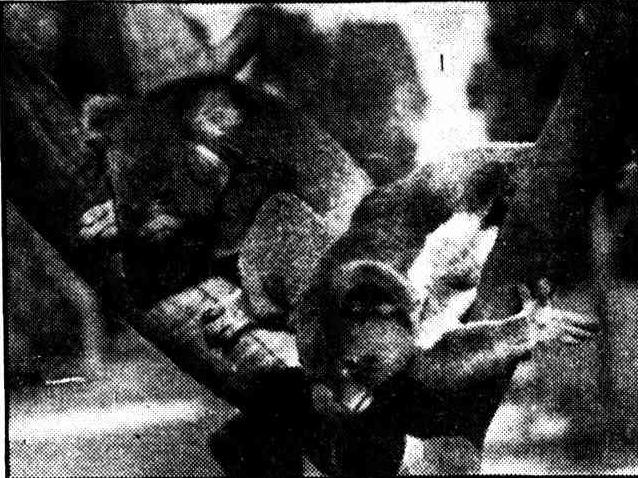
"WHAT GIVES DOWN THERE?"
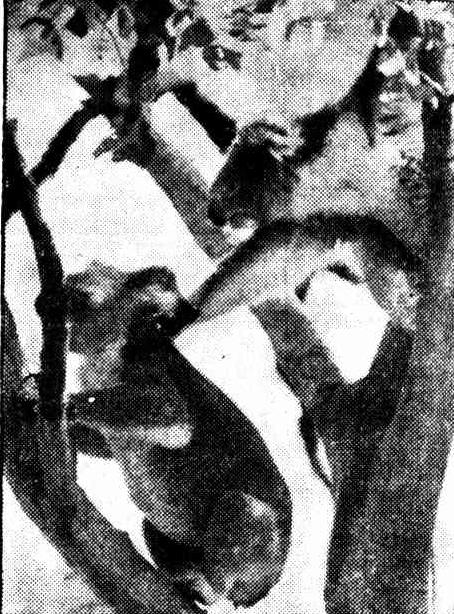
"NOW THEN, BUZZ OFF."
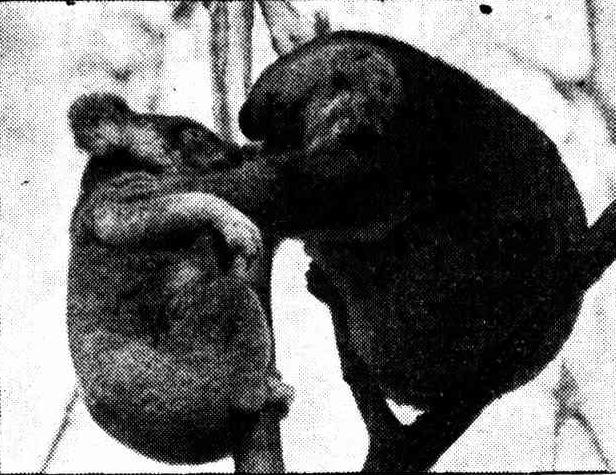
"CAREFUL, COBBER"
FAR behind what the world has come to call the Iron Curtain, in a tiny wooden village schoolhouse in Bessarabia, I was once shown a postcard which the aged schoolmaster carried carefully in his wallet, in just the same way as a soldier carries the photograph of his wife or sweetheart. He had shown it to his class year after year when the geography lesson on Australia came round, and was never tired of displaying it at night under an oil lamp to the gaping peasants in the village wine-shop. It was the worn photo of a Dinkum- Aussie who has done more to publicise Australia abroad than the Department of Information and the Departments of Tourism put together — the koala.
Throughout the Continent, in all sorts of odd places, I came across photos of our little ambassador, who knows no politics, and who has captured the world's imagination even more than the kangaroo or the platypus. In hotel, bars, cafes, restaurants you had to be ready to brush up your zoological knowledge of the koala, the kangaroo and the platypus once it became known that you came from Australia Wheat, wool and gold, Australia's rapid march in industry, arid its civilisation meant little in the school geography books beside our remnants of the fauna of a bygone geological age-saved from extinction long ago by a timely land-subsidence which cut our continent off from Asia.
To foreign eyes this land of ours is a living museum of ancient geological forms of life— a place where evolution stopped, another "Lost World" with monotremes and marsupials instead of the pterodactyls and dinosaurs. If there is any animal which has become a martyr to human greed and cruelty, it is the gentle, inoffensive koala; if any animal has a damning indictment to present against humanity, it is the koala. In the days of our first settlers, it was flourishing almost everywhere except in Western Australia. But the harmless little gumtip-eater had the bad luck to possess a strong hide and a lovely fur which would stand up to a lot of wear. That started the white man's slaughter of the innocent. More than a million were killed and their skin's exported to America (under the name of "wombat" skins, in order to allay any public outcry). Only 25 years, ago, American fur catalogues still listed them as such. Under the depredations of the fur-hunters, the koala began to shrink fast in number. Then came the virus disease which swept Australia's animal life, killing off countless numbers of marsupials of other species, as well as the koala. The harmless koala began to disappear everywhere except in Queensland, where it had been on the list of totally protected animals. Then followed the "depression" killings, when the Queensland Government lifted its protection from koalas to give "employment" to workless and raise money from the furs. Tens of thousands were ruthlessly shot down from their trees, in spite of loud protests from conservationists who were awake to the fact that one single live koala was worth, as a tourist attraction, a thousand killed for their skins. The only country on earth with koalas was robbing itself of the greatest tourist draw on earth.
After the "depression" massacre, Australia suddenly woke up to the fact that there were only about 100 koalas left in NSW, about 300 in Victoria; and in Queensland, where there had been a million, only a few thousand. It was thanks to men like Keith Minchin, in South Australia, Noel Burnet, at Koala Park, NSW, and other informed and capable conservationists (as well as the extension of the Native Flora and Fauna Protection Acts), that the koala was narrowly saved from extinction along with the pretty little Toolachi wallaby and the other harmless and beautiful wild creatures which have become extinct within living memory.
In response to public pressure, the NSW Fauna Protection Panel was set up several months ago under Chief Fauna Protector Mr. F. J. Griffiths. Among the 14 other members of the unpaid panel, is Mr. E. J. Hallstrom, Sydney philanthropist and animal lover, as Deputy Fauna Protector. The panel's programme is a comprehensive one for the restoration, protection and maintenance of our wildlife. Its first job is to find out what the koala population stands at, where it is distributed and how it is getting along. Re-populating areas where the koala once lived, but from which they have disappeared, is also on the agenda.. Through the Press and over the radio, the panel is seeking information and help from the public, and is gradually piecing together the information it is gathering. It has already established that the koala-colonies exist in some 100 places in the State, almost all along our eastern seaboard, and thickest on the Far North Coast. Very few are found west of the Blue Mountains now. Mr. Griffiths believes that the past five lush seasons ' and the. relatively few bush-fires have boosted Australia's animal and bird, populations to the highest level in long years. Although there are today some 350 game sanctuaries in this State, they are giving little or no real protection to our wild life. The panel is considering the establishment of special reserves in different parts of NSW to include all forms of our wild life. These will be under the control of the panel and will be subject to special supervision by appointed officers.
One other aspect of the panel's work is to set up at Mona Vale an experimental station to breed and study koalas on 40 acres of land made available by Mr. Hallstrom. All native wild animals (except pests such as the dingo and the flying-fox) are fully protected under the Protection Act. With the exception of the koala and the lyre-bird, they can be exported only to foreign zoos or scientific institutions. The koala and the lyrebird cannot be taken outside Australia under any circumstance. Neither can they be owned by anybody but the Crown. The panel is expected to make the same ruling for the platypus. Killing of any protected bird or animal may bring a fine of up to £50. Possession of a skin carries the same penalty. Shooting a kangaroo carries the same, penalty except during an open season, declared when the animal is proved to be a pest. No reptile is protected in Australia. While most native birds are protected, the Fauna Protection Panel is particularly interested in getting information of the whereabouts of the lyre-bird. If you are caught killing a lyre-bird you can expect the full £50 penalty! The kookaburra, although claimed by some to be a pest, is protected. If protection were dropped, a storm of sentimental protest would blow up overnight, Mr. Griffiths believes. The wedge-tailed eagle (of the species which recently created a sensation at King's Cross when it attacked a woman and her child) is the biggest' eagle in the world. The panel does not know what to do about the wedge-tailed eagle. They would like to protect it, but it has occasionally been known to attack lambs. Manufacturers of toy koalas have made huge profits from the public's love of the dreamy-eyed little marsupial. Overseas visitors to these shores have taken away thousands of them, including American "Queen for a Day" Mrs. Mortensen's last-minute gilt of an armful when she left by plane last December. Our postal stamps have made the koala known abroad, and hundreds of thousands of postcards (manufacturers say the koala card is No. 1 seller) have gone to all parts of the civilised world. . It was the State Minister for Tourism (Mr. G. J. Arthur) who rushed the toy koalas to- Mrs. Mortensen at the airport-This is the Minister's comment on the koala: — "The koala and our other unique animals and birds are our trump tourist draw-card. They can earn us fortunes from tourists jaded by the monotonous attractions in other countries. . . . We must not grudge money spent on their care or on koala parks." Plan to save our koalas (1950, February 9). The Sun (Sydney, NSW : 1910 - 1954), , p. 24 (LATE FINAL EXTRA). Retrieved fromhttp://nla.gov.au/nla.news-article230079332
Leon Gellert Finds Himself.. AMONG THE KOALAS
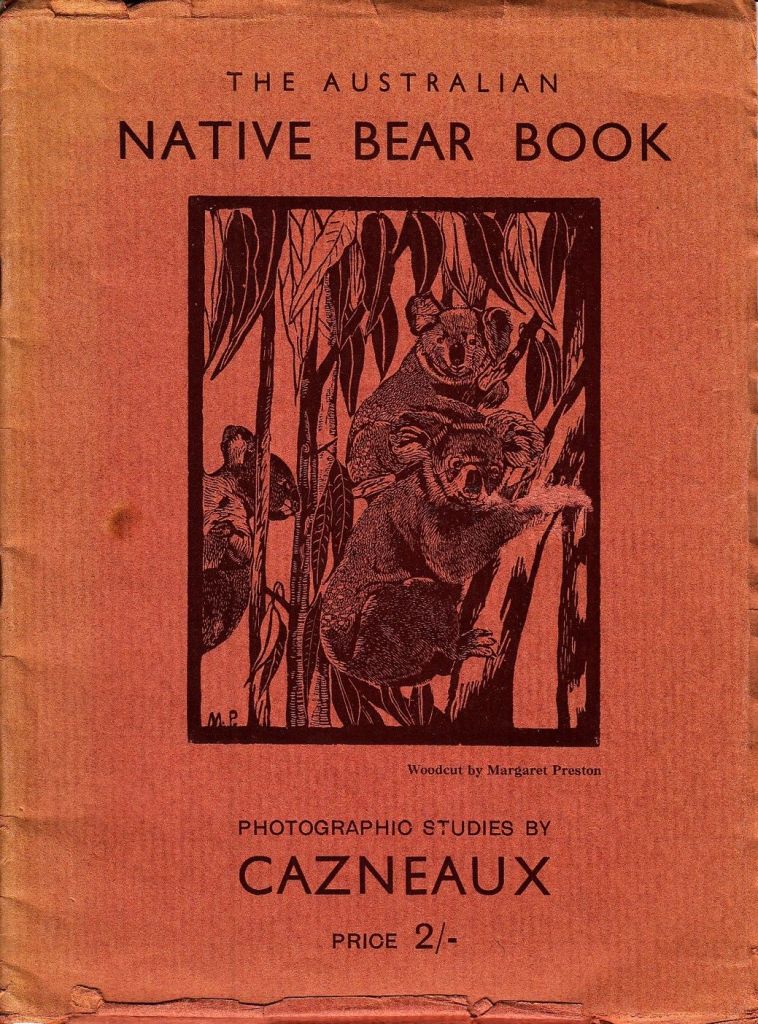 AN incensed reader has sent me a newspaper clipping in which, she claims, a libellous injustice has been done to a koala. It states that at Mona Vale one of these animals bit and poisoned the hand of a solicitous naturalist who was trying to succour it - a Mr. John Hallstrom. The name seems familiar. Were there any truth in this alarming story it could only be assumed that the unhappy marsupial, immeasurably wiser than its kind, singled out that particular hand as most deserving the honour of the first koala-bite in history.
AN incensed reader has sent me a newspaper clipping in which, she claims, a libellous injustice has been done to a koala. It states that at Mona Vale one of these animals bit and poisoned the hand of a solicitous naturalist who was trying to succour it - a Mr. John Hallstrom. The name seems familiar. Were there any truth in this alarming story it could only be assumed that the unhappy marsupial, immeasurably wiser than its kind, singled out that particular hand as most deserving the honour of the first koala-bite in history.
Such reckless stories of the ferocity of our native bears may have their uses. Apart from frightening us into barring our doors more securely at night, they should act as a warning to those foolhardy wayfarers who are always eager to rescue a country's fauna from its natural surroundings.
Man, in his dealings with creatures of the wild, suffers many misadventures. He may be torn asunder by raging silkworms, brutally battered to death by butterflies or trampled underfoot by stampeding ladybirds, but he is never, never, never bitten by koalas.
This is not to say that every-body who chooses to play fast and loose with a koala comes away unscathed.. The single occasion on which I engaged one of the species single-handed proved to be a pretty bloody affair.
MANY years ago my friend Harold Cazneaux (the celebrated photographer) and I were assigned to bring out an illustrated booklet on the Australian native bear. During the preliminary operations of getting facts and photographs at Koala Park, Mr. Noel Burner, the director of the sanctuary, placed an exquisite cub of about seven inches long in my arms while he and Cazneaux went in search of a larger specimen.
Mistaking me for the bole of a stunted bluegum, the animal began to mount, hand over hand,[for the topmost branches where, if instinct could be relied upon, the most succulent pastures were to be found. I tried as gently as possible to thwart its purpose, but my tender restraint was met with a cheerful but desperate opposition. The harder I tugged, the deeper its needle-sharp claws dug in.
Having negotiated my vest, it scrambled from one chin to the next and began its ascent of the face, itself, where the yielding, penetrable tissues were more to its liking. Eventually it gained the summit and, as far as I remember,- settled down among the sparse undergrowth and quietly dropped off to sleep.
By the time Mr. Burnet returned my countenance was ashambles. But, there and then, I was given a lesson in the correct method of disengaging a koala bear from the human face. The procedure is much like removing a cluster of fishhooks that have become embedded in the flesh. The booklet is long since out of print and Mr. Cazneaux's incomparable photographs have circulated on their own merits and have been acclaimed in every quarter of the globe.
THE publication I speak of was an inexpensive little thing, and I can recall only one other incident in connection with it, and that was a true story that my friend Hemsley told me while it was in preparation.
Hemsley is one of those kindly, sensitive mortals who shudder visibly at the very thought of pain wantonly inflicted.
One evening, as we were travelling together on the ferry-boat from the city, I told him of our prospective brochure on the koala, and saw him wince at the mention of the name. After some moments of grave silence he came out with his story. It was simple and brief.
"It was towards the end of my knicker bocker days," said Hemsley. "There were three of us all boys of about the same age and armed with pea-rifles, we had set out across country one morning for a day's rabbit-shooting.
"We had tramped through the fields and low-lying paddocks for hours. We had scattered through the stubble and peered into burrows. We had combed the bushes and the dead wood for miles around but with no sight of a rabbit, except, here and there, a vanishing tail.
.jpg?timestamp=1471781871586)
"By midday not a shot had been fired. And then someone suggested that we make our way up the gentle slope of ground to the foothills where, out of reach of the sun, under the tall timber we could eat our lunch.
.jpg?timestamp=1471781937205) "AS soon as we got well into the belt of towering gums we collapsed forlorn and frustrated at the foot of the largest of then and lay there on our back munching and grumbling.
"AS soon as we got well into the belt of towering gums we collapsed forlorn and frustrated at the foot of the largest of then and lay there on our back munching and grumbling.
"Revived by our meal, we gathered enough energy to make a target of a young sapling. But we soon wearied of sapling shooting and once more lay on our backs in the shade looking up at the blue fragments of sky showing through the distant wickerwork of leaves. It was close timber and the lowest branches emerged from their trunks some twenty feet from the ground.
"Suddenly the idling eyes one of us descried a small brown shape huddled in the delicate fork of the highest limb of our tree. It swayed in the mild wind overhead like a tiny mariner caught in the farthest rigging. And although none of us had seen one we all knew that it was a koala.
"There was great excitement. Game at last!-and nicely silhouetted against a clear heaven.
"After the usual dispute as to whose privilege it was to have the first shot we were all at it firm singly, at first, and then in volleys
"The brown shape continued to swing unconcernedly and then someone scored a hit.
"There were yells of delight as our marksmanship improved and we could hear our bullets find their mark.
"Slowly the small brown bundle began to stir, unfolding itself like a woollen glove. And then we saw a drop of blood among the dead leaves at our feet. Another drop fell beside it and another. It wouldn't be long now, we thought, before that clump of fur came tumbling down. It must be fairly riddled with lead by this time.
"Nevertheless a feeling of un-easiness had set in. From away up in the tree-top there came drifting down to us a sound that made us lower our rifles and stand close together-a white faced little group, paralysed with awe. It began as a soft whimpering such as might have come from a forsaken child and swelled to the terrible grief-stricken lamentation of a heart hopelessly broken. It went on and on.
THERE was no protest in that piteous crying-only an inconsolable anguish. And as the moaning continued we noticed that the bear had begun to move.
"It was coming down-not falling down, but slowly, falteringly groping its way along the branch to the main stem, weeping and shaking its head from side to side as it paused, every now and again, to steady itself.
"Eventually it arrived at the lowest limb and commenced its backward descent of the smooth trunk. Never was progress so slow.
"And all the time we stood there watching and listening watching its poor feet fumble for a grip so that pieces of bark came clattering down-listening to that interminable crying of despair.
"When at last it reached the ground, it hesitated for a second or two and then, as though it had lost the power to see, it came stumbling to where we stood petrified with shame and horror. And there it sank at our feet.
"Not till we had realised that it was dead did we notice, clinging to its back, another diminutive bear looking up at us with bright beady eyes. It seemed as though that heroic mother had, with its last gasp, trustingly committed her cub into our care.
"I tell you that during the whole of that horrible journey home none of us spoke a single word. And since that day I have never touched a firearm of any kind."
COULD see that Hemsley was considerably upset. But it was time for me to leave him. The boat was drawing into my wharf.
As I rose to go I said, "And what became of the . . ."
But somehow I could not get the words out of my mouth. With a dumb gesture of understanding I left him sitting there.
Leon Gellert Finds Himself.. (1950, October 15). The Sunday Herald (Sydney, NSW : 1949 - 1953), , p. 2. Retrieved from http://nla.gov.au/nla.news-article28670685
The Koala sanctuary was also used as a breeding place with some koalas being sent to the United States of America, despite a ban on exporting these creatures, in 1952 to be part of a film ‘Botany Bay’. Released in 1953 this American drama directed by John Farrow and starring Alan Ladd, James Mason and Patricia Medina was based on a novel of the same name by Charles Nordhoff and James Norman Hall. Two kangaroos were also flown in to appear the film.
Hollywood "limit" on koalas Sydney, Thursday: Four koala bears being flown to Hollywood on Sunday for the film "Botany Bay'' must be returned within six months, an official of the N.S.W. Chief Secretary's Department said today. Any young born to the bears, two males and two females, also must be re-turned, he added. About 56lb. of gum leaves will be on the plane to feed the bears on their 40-hourtrip. Mr. E. J. Hallstrom, Sydney philanthropist, said today the State Government had issued a' special permit for the bears to leave Australia for the first time since their export was banned 25 years ago. "Probably about 2,000,000 people will see the bears during their stay at San Diego Zoo, where they will be expertly cared for," Mr. Hallstrom said. Hollywood "limit" on koalas. (1952, January 4). The Argus(Melbourne, Vic. : 1848 - 1956), p. 3. Retrieved from http://nla.gov.au/nla.news-article23155540
These koalas came from the Mona Vale Sanctuary and recognised Hallstrom when he visited them at the San Diego Zoo late in January 1952. Sir Hallstrom ran into controversy during this episode which he resolved with customary logic:
We Might Lose Our 4 Koalas; Canberra. - Four koala bears flown to America for a film, "Botany Bay," don't know all the fuss they're causing back home. Mr. Clive Evatt, N.S.W. Chief Secretary, who authorised the bears' departure, wants them returned to Australia. But Sir Earle Page, Federal Health Minister, says the Commonwealth will not allow the animals to return by air, because disease might be introduced. He doesn't mind if they come by sea, spending a quarantine period on the way. Mr. E. J. Hallstrom, from whose private sanctuary the bears were taken, says they could not survive a sea trip, and wants them to stay in America. Unless they return to Australia in the form of a skin rug, the bears look like forming the first permanent koala colony outside Australia. We Might Lose Our 4 Koalas. (1952, February 12). Barrier Miner (Broken Hill, NSW : 1888 - 1954), p. 3. Retrieved from http://nla.gov.au/nla.news-article49235794
However, they will remain in the zoo on indefinite loan from the Taronga Park Zoological Gardens in Sydney. This loan from the 'land of living fossils' is expected to last as long as the small marsupials do well in San Diego. 'It is purely an experiment,' Mr. Hallstrom said. There are not likely to be any other koalas exported because of the strict embargo imposed by the Government when they almost became extinct a quarter of a century ago. The need for Mr. Hallstrom's brief visit arose, he explained, after Mrs. Benchley directed so many fineries to him about the koalas' care that answers would have become encyclopaedic if he tried to write them down. He said he examined the bears this morning and they appear to be adjusting quite well to California's varieties of eucalyptus, the koala's only diet. He added he was satisfied with Mrs. Benchley’s plans for a spacious koala enclosure. | Four Koalas Loaned to America. (1952, March 14).Centralian Advocate (Alice Springs, NT : 1947 - 1954), p. 15. Retrieved from http://nla.gov.au/nla.news-article59835828
SOMETHING TO BEAT THE CHEST ABOUT: "I can 'sell' the Zoo like nobody else," says 71-year-old Mrs. Belle Benchley, director of the San Diego Zoo, who describes herself as "rather a plain person-always the most inconspicuous person aboard a plane, and no relation of Robert's." An old friend, Sir Edward Hallstrom, was there to meet Mrs. Benchley and they drove straight from Rose Bay to Taronga Park. "We have many more monkeys and apes than you have, but only two rhinos-you have five or six-and your trees full of koalas. I'd like to pick me up another koala. "Our zoo," she added, "is the only zoo in the world, outside Australia, with koalas. Now isn't that something to beat your chest about'? SOMETHING TO BEAT THE CHEST ABOUT. (1954, April 6).The Sydney Morning Herald (NSW : 1842 - 1954), p. 8. Retrieved from http://nla.gov.au/nla.news-article18418704
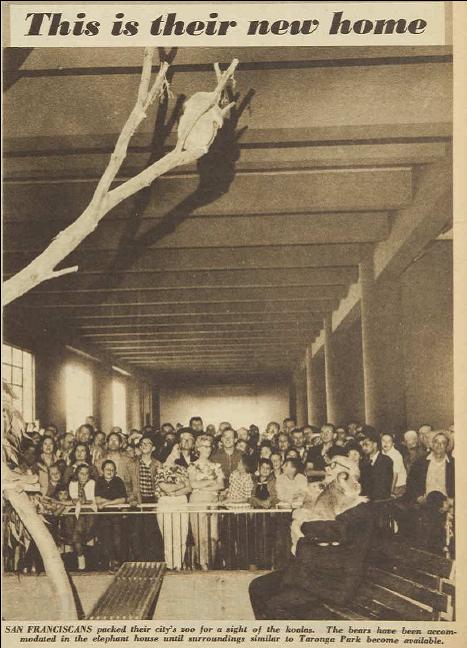
Although the koalas appeared at first to be adapting well to their new environment and diet they did not live as long as they may have at home. In 1959 this gentleman was able to send more koalas from his Mona Vale Koala sanctuary to zoos in the US:
AMERICAN ZOOS GET SIX
KOALAS-PLUS;
Californians considered themselves lucky when, despite many
Australian protests, they recently got six koalas from Sydney. Now, in San
Francisco, Sir Edward Hallstrom has announced that two of the bears will soon
have babies. LEAVING for the U.S., Blinky Bill, one of the six koalas, had a
last look at Sydney from the arms of air hostess Audrey Bailey.
SIR EDWARD,
chairman of Sydney's Taronga Park Zoo Trust, travelled with the six koalas on
their flight to America earlier this month. They are the only koalas in
captivity outside Australia. Soon after their arrival in San Francisco he said
that two of the females had been mated. The city's Fleishacker Zoo could expect
more "teddy bears" soon. The bears-two males and four females-come from Sir
Edward Hallstrom's animal sanctuary at Mona Vale, N.S.W. Three will be kept
in the San Francisco zoo and three will go to San Diego, where the last koala in
America died a few months ago.
Enormous crowds of men, women, and children
queued for the first sight of the furry little animals in San Francisco. Sir
Edward Hallstrom was pleased to note the koalas' appetites, and predicted a long
and happy life in California for them. A local newspaper is running a contest
for children, offering prizes for the best names for the koalas. Sir Edward, who
has received the key to the city for his gift, made a careful inspection of the
elephant house and pronounced it "very fine temporary accommodation." He
suggested, however, that 15ft. be trimmed from the eucalyptus tree to forestall
the bears jumping on to a nearby roof. San Francisco Zoo director Mr. Clarey
Baldwin said the permanent site for the koalas would be modelled closely upon
the facilities at Taronga Park. AMERICAN ZOOS GET SIX KOALAS — PLUS.
(1959, April 29). The Australian Women's Weekly (1933
- 1982), p. 5. Retrieved from http://nla.gov.au/nla.news-article51774539
At Mona Vale the farm of 40 acres known as the 'Zoo Farm’ produced feed for the creatures of Taronga Zoo - this was between Basset and Darley streets. The farm was managed by Charlie Bishop with other workers including Stan Wenman and Brian Godwin. The land was purchased in 1947 by Sir Edward Hallstrom (1886-1970) solely for this purpose. A member of the Taronga Zoo Park Trust from 1941 to 1959, its president from 1948 to 1959 and honorary director until 1967, an animal lover from an early age, Mr Hallstrom thought the farm would ensure the animals in his keeping would have the fresh food they required.
During the 1960’s the food from the farm was analysed and found to be lacking in Vitamin E and the lucerne far too rich for the animals it had been grown for. By the 1970’s the Western Plains Zoo began producing hay for the Taronga zoo and the farm was subdivided and sold from 1956 on until the last parcel had been bought in 1984.
The Koala Sanctuary was known as the Bellbird Estate by 1977 and although used for 'orientation' runs by local schoolchildren, who recall lots of koalas in the trees there, the sanctuary was gone. As seen above, from 1975 on the plans for a retirement village on the site, along with gardens being built up the hill, now called Minkara, were progressed, as can be read in the opening paragraphs above. This would have required the removal of many of the food trees for the koalas.
The lands at Mona Vale on and around Bassett and Darley Street were also brought under the Real Property Act and sold off, although clearly not all of these, are listed as:
No. 38028 Edward John Lees Hallstrom 3 a. 1 r. 251 P- lot 56 sec. 1 Mona Vale Est. Bassett St. Mona Vale.
No. 38029 Edward John Lees Hallstrom 2 a. 1 r. 39 1/2 p. pt. lot 57 sec. 1 Mona Vale Est. Darley St. Mona Vale. REAL PROPERTY ACT NOTICE. (1953, August 14). Government Gazette of the State of New South Wales (Sydney, NSW : 1901 - 2001), p. 2601. Retrieved from http://nla.gov.au/nla.news-article220067730
No: 38027 Edward John Lees Hallstrom 5 a. 2 1/2 p, Lot 54 sec. 1 , Mona Vale Est. Darley St. Mona Vale. REAL PROPERTY ACT NOTICE, (1954, January 29). Government Gazette of the State of New South Wales (Sydney, NSW : 1901 - 2001), p. 288. Retrieved from http://nla.gov.au/nla.news-article220289165
No. 39128 Edward John Lees Hallstrom 3 r. 39 1.2 p. pt. lots 51 and 52 sec. 1 Mona Vale Est. Mona St. Mona Vale.
No. 39129 Edward John Lees Hallstrom 3 a 2 1/2 p. lot B in M.P.S. (O.S.) 5270 Bassett St. Mona Vale. REAL PROPERTY ACT NOTICE. (1956, June 15). Government Gazette of the State of New South Wales (Sydney, NSW : 1901 - 2001), p. 1646. Retrieved from http://nla.gov.au/nla.news-article220304536
No. 38030 Edward John Lees Hallstrom 2 a. 3 r. 39 p. lot 59 of Sec. 1 of the Mona Vale Estate Bassett St. Mona Vale. REAL PROPERTY ACT NOTICE (1960, September 9). Government Gazette of the State of New South Wales (Sydney, NSW : 1901 - 2001), p. 2862. Retrieved from http://nla.gov.au/nla.news-article220316080
Worth noting is that Mr. Hallstrom continued to try to save koalas, even close to the time he passed away:
Opportunity For Koala Sanctuary
Sir. — Philanthropist Sir Edward Hallstrom, director of the Sydney Zoo, has offered to donate a sum of £10,000 for the establishment of a sanctuary for koalas, that friendly, most lovable of Australia's fauna. Sir Edward's only conditions are that the reservation should be under Government control and that the site chosen should be one suited for the marsupials' dietary needs and secure from molestation in breeding time.
The koala, or native bear, as it was known by our pioneers, was plentiful in the district a century ago. It kept mainly to the widespreading gums along the river flats. It was useless for food, because of its flesh being so highly impregnated with eucalyptus. Even the abos, except under the stress of drought, passed it by for the more succulent, grass-eating 'roo and wallaby.
Our pioneers did tan a few skins for mats, but they were of no commercial value and country stores-would not buy even at the current rate for possum skins, 2/- a dozen.
The native bear did not suffer severely until the district became more settled and the sportive youths gave up the more tiresome snaring of possums for the quicker muzzle-loader with homemade shot for possums and slugs and lightweight bullets for bigger furred marsupials. Then it was that the poor old koala, always exposed on tree branches, with no protection, soon began to fade away.
A koala sanctuary in the vicinity of Canberra would be a joy to youngsters, in addition to an attraction for the ever increasing number of tourists.
The Development Commission has plans for the expenditure of some millions over the next five years. Maybe the pruning shears could be employed in snipping off a few thousands for a koala sanctuary. Bricks and mortar are very necessary in the capital for homes and business, but they do not make up everything in human character.
The inculcation of a love of nature in our impression-able youth can be a wonderful character-builder, bearing fruit even into old age.
The quaint, lovable koala would be hard to supplant in juvenile affection.
W. P. BLUETT
Brindabella. Opportunity For Koala Sanctuary (1959, May 13). The Canberra Times (ACT : 1926 - 1995), p. 2. Retrieved from http://nla.gov.au/nla.news-article128815517
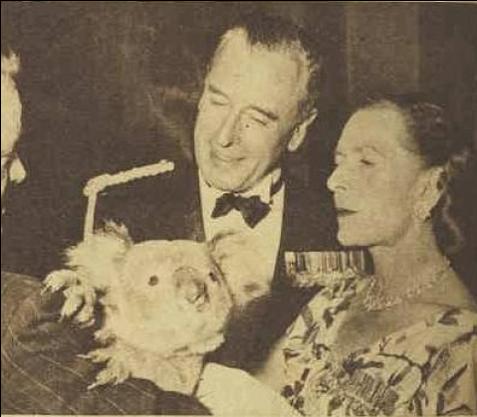
GEORGE, the four-year-old koala, was the guest of honor at a naval reception given by Rear-Admiral Buchanan. Sir Edward Hallstrom sent the bear after hearing Lady Mountbatten had never seen one. SEA LORD'S VISIT. (1956, April 18). The Australian Women's Weekly (1933 - 1982), p. 24. Retrieved from http://nla.gov.au/nla.news-article51776056
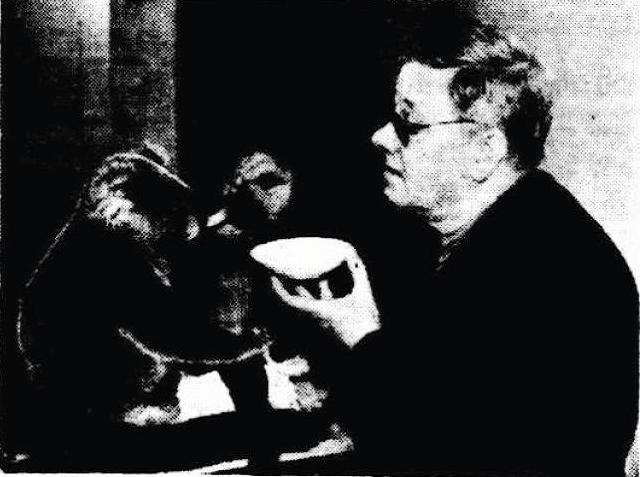
INJURED KOALA AS PATIENT); Koala being fed on milk by Mr J. Hallstrom, of Willoughby (NSW), who is nursing it back to health despite two broken hind legs and a broken forefoot. The bear is tied to a rubber cushion, has its injured limbs in plaster, and supports itself by the upright post. INJURED KOALA AS PATIENT. (1943, December 1). The Mercury (Hobart, Tas. : 1860 - 1954), p. 6. Retrieved from http://nla.gov.au/nla.news-article25981748
Australian newsreel item, title reads: "Rare
Albinos". 1940 or 1949? Watch full video (Pathe
does not allow publication) at: www.britishpathe.com/video/albinos-bears-and-kangaroo-aka-koala-kangaroo/query/koalas
Two
albino koala bears in E J Hallstrom's Mona Vale sanctuary, feeding in a tree. (2
shots). CU Koala eating a leaf. (2 shots). MS White koala bear walking along
ground. MS and CU Six-month old albino Kangaroo named "Girlie", being by E J
Hallstrom.
Bayview-Mona Vale Koala Sanctuary
Date found in the old record - 16/02/1962.
Published by British Pathé - ''Sir Edward Hallstrom with two companions strolling through his sanctuary where he tries to preserve breeds of animals that like the Koala are near extinction [in Pittwater]. ''
More in Sir Edward John Lees Hallstrom
Date found in the old record - 16/02/1962.
Published by British Pathé - ''Sir Edward Hallstrom with two companions strolling through his sanctuary where he tries to preserve breeds of animals that like the Koala are near extinction [in Pittwater]. ''
More in Sir Edward John Lees Hallstrom
Koala Bears Threatened By Extinction 1962 -
Video
A valley in the Australian bush land, E J Hallstrom's
Mona Vale sanctuary. Date found in the old record - 16/02/1962. Koala bear.
Various shots of the koala bears walking climbing trees and playing in them MS.
Two kangaroos standing by trees. Sir Edward Hallstrom with two companions
strolling through his sanctuary where he tries to preserve breeds of animals
that like the Koala are near extinction. Koala mother with baby on back climbs
tree. Sir Edward Hallstrom looking up into tree. Various shots of koala bears.
Watch full video (Pathe does not allow publication) at: www.britishpathe.com/video/koala-bears-threatened-by-extinction/query/koala+bears
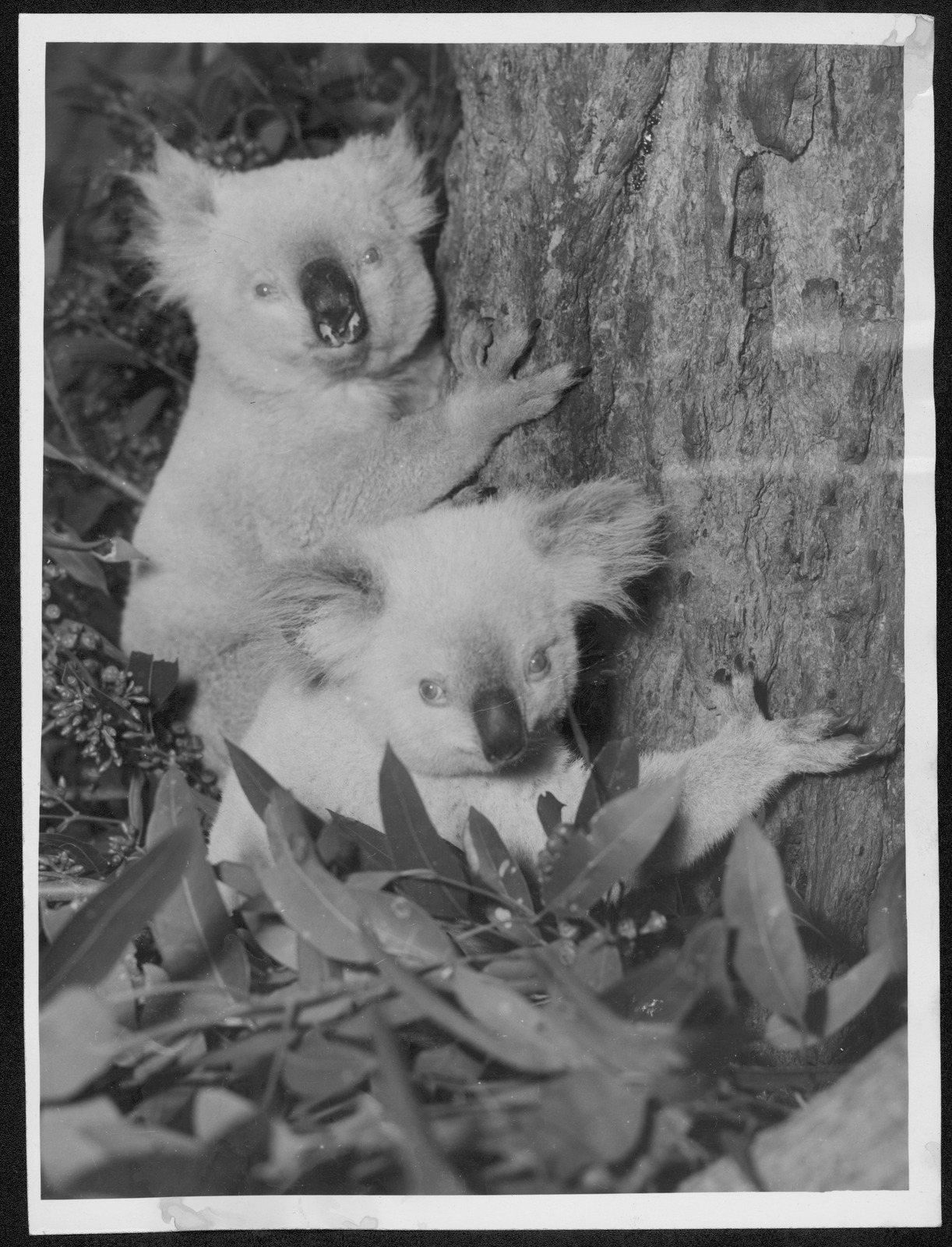
Two white koala bears [i.e. koalas] which Sir Edward Hallstrom has bred. [picture]. Sir Edward, of the Taronga Zoo Trust had taken almost six years to develop the pure white strain of koala. [ca. 1935] Argus Newspaper Collection of Photographs, courtesy State Library of Victoria. Date on reverse of photograph.

White koala bear bred by Sir Edward Hallstrom, Chairman of zoo [picture] [1953] 1953, courtesy State Library of Victoria
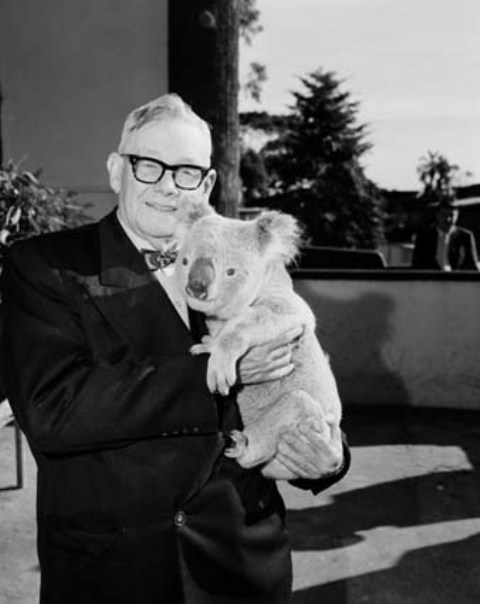
Sir Edward Hallstrom, with a Koala at Taronga Park Zoo 1964. Sir Edward grows the special variety of eucalypt leaves needed for koalas diet PRINCIPAL CREDIT: photographer J Fitzpatrick. From and Courtesy of Australian National Archives Image no. : A1200, L47870.
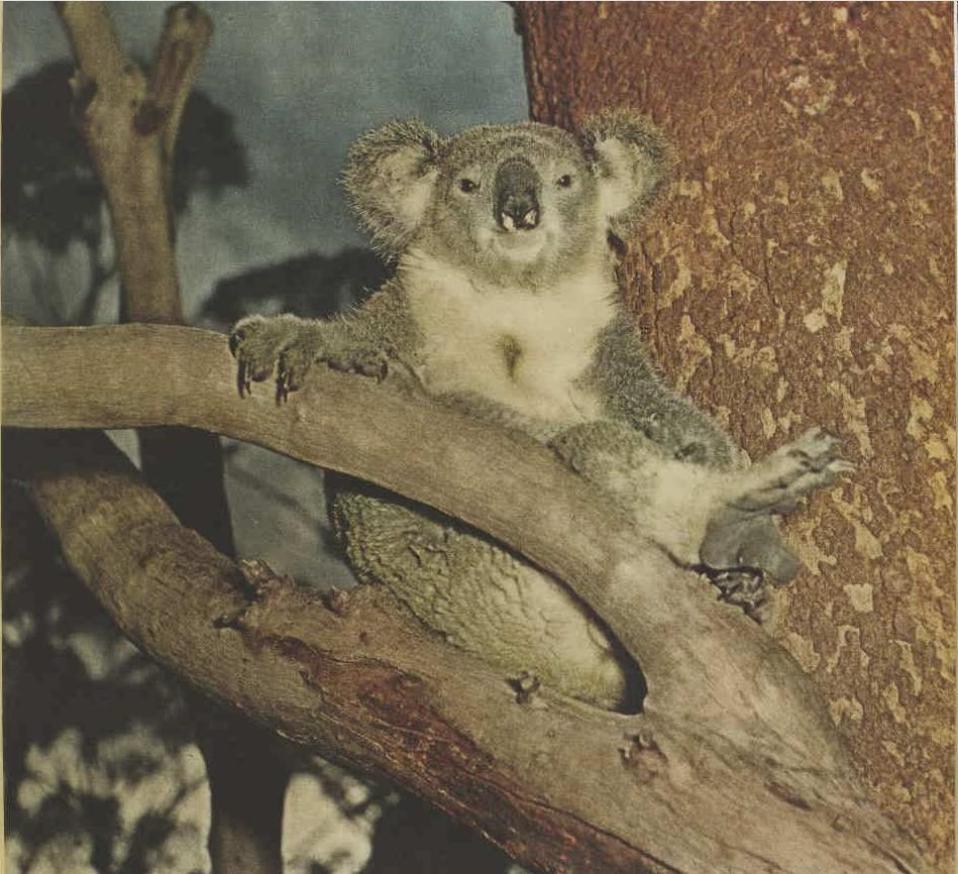
May 10, 2019: Australian Koala Foundation report states koalas are ‘functionally extinct’ - Photo: Koala in Mona Vale in 1958 from Australian Women's Weekly Article - Koalas are definitely extinct in Pittwater.
Extras
"KOALA AN ASSET." Plea for Preservation.
Two of five koalas injured in bush fires at Newport on Saturday have died from exhaustion. The three bears which remain are being treated at Koala Park. The secretary of the Koala Club of Australia. Mr. Frank L. Edwards, said yesterday that, during 1937 and 1938, the club had participated in the rescue of nine maimed bears from the Pittwater district.
"At this rate," he added, "the animals will vanish from that district in three or four years. As there are not 200 of them left in New South Wales, this is a tragedy. Koalas, one of our best animal assets, are allowed to stray to their rapid destruction, as in the Pittwater district while the law requires that other stock be paddocked.
"If we lose them." Mr Edwards added, "twould be of little use to talk of stocking up with koalas from elsewhere. The States are already refusing to transfer koalas and, In any case, the Queensland and Victorian native bear's are different types from ours." "KOALA AN ASSET.". (1939, January 17). The Sydney Morning Herald (NSW : 1842 - 1954), p. 10. Retrieved from http://nla.gov.au/nla.news-article27976025
A Bushfire Casualty
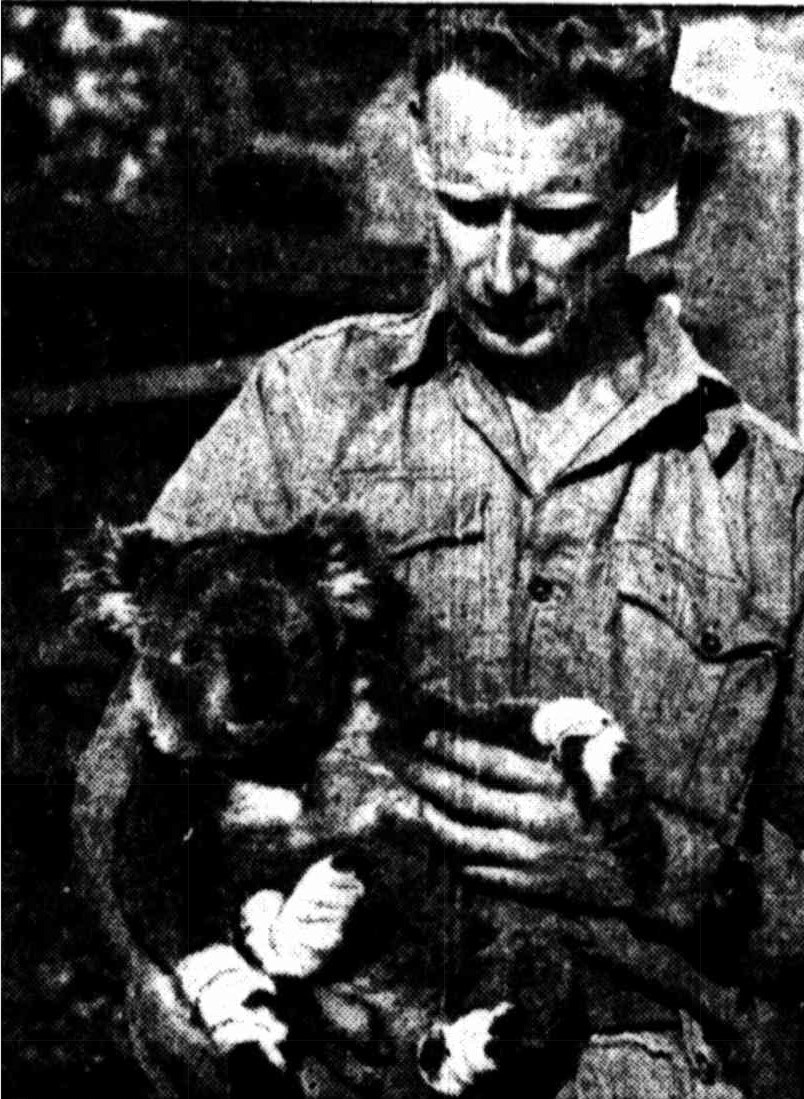
FIRE CASUALTY.- Paws bandaged, this koala was in safe hands at Taronga Park Zoo, on Saturday, after getting prompt attention for burns received in the bushfire at North Narrabeen. A Bushfire Casualty (1946, November 6). Queensland Times (Ipswich, Qld. : 1909 - 1954), p. 1 (DAILY). Retrieved from http://nla.gov.au/nla.news-article118381832
Kuring-gai Reserve For Koalas
The Chief Secretary, Mr.
Clive Evatt, announced last night that the Government had granted £7,500 to
establish a koala reserve in Kuring-gai Chase. Mr. Evatt said the president of
the Kuring-gai Chase Trust, Mr. Colin Burnside, other members of the trust, and
the Fauna Protection Panel had chosen a suitable site.
It was between Bobbin
Head and Mount Colah, and covered about 100 acres. The site had every advantage
needed to make an ideal home for koalas and other native animals. HELP OFFERED
Mr. E. .J. Hallstrom, well known philanthropist and deputy chairman of the Fauna
Protection Panel (established 1948), had offered to help the trust in any way
possible. Mr. Evatt commended the trust on its public spirit in establishing the
reserve. He said he hoped other trusts and authorities would follow its good
example. Kuring-gai Reserve For Koalas. (1950, July 22). The Sydney Morning
Herald (NSW : 1842 - 1954), p. 3. Retrieved from http://nla.gov.au/nla.news-article27573919
New Boat For Rescue Men
Sydney philanthropist Sir Edward
Hallstrom will buy a new surfboat for North Narrabeen lifesavers to replace the
one they lost on Friday night in a rough weather rescue. Sir Edward said last
night that the lifesavers showed great courage in rowing four miles at night
through mountainous seas. He told a "Sunday Herald" reporter: "Tell the surf
club to get in touch with me. I'll get them a new boat."
The president of the
North Narrabeen Surf Club, Mr. J.King, said: "We'll get in touch with him
immediately."
Towed Five Miles Out To Sea
The
surfboat-which cost' £400 two years ago-was lost when six lifesavers went to
rescue Mr. and Mrs. Rupert Kathner from their 27ftauxiliary yacht Alcyone 11, in
danger of being smashed on rocks near Mona Vale. The yacht, with its rudder
smashed, was only 30 yards from the rocks when the surf-boat reached it.
One
of the lifesavers, KenHodges, dived from the surf-boat and swam with lines to
the yacht, which was towed five miles out to sea.
Twice the line snapped and.
both boats were in peril when the police launch Nemesis took the Kathners and
the lifesavers on board.
The surfboat, leaking badly, sank. Other lifesavers
who took part in the rescue were Jim Mason, Norman Ambrose, Ron Well, Les Brown,
and R. Noonan.
They were at a dance at North Narrabeen Surf Club when
Sergeant Adams, of Narrabeen police, sought their help. Mrs. Kathner, of Rose
Bay said last night: "All concerned in the rescue did a colossal job.
Could
See Rocks Looming Up: "We could see the rocks looming up when Ken Hodges dived
from the surfboat and passed us a line. It was a nightmare when the line broke.
"I don't know how the surf-boat battled through the seas. It was the most
courageous feat of endurance I have ever seen. "Time and time again I thought it
would sink before other help arrived."
Towed by the Nemesis, the yacht
reached its mooring at Rose Bay shortly after 4 a.m. yesterday. The rescue
operations had lasted for more than seven hours.
TAILPIECE.-A new surf-boat
will cost about £450. New Boat For Rescue Men. (1952, December
28). The Sunday Herald (Sydney, NSW : 1949 - 1953), p. 3.
Retrieved from http://nla.gov.au/nla.news-article18504886
GOVERNMENT NOTICES - REAL PROPERTY ACT
NOTICE
Applications have been made to bring the undermentioned lands
under the Real Property Act. Plans may be inspected and caveats lodged at the
Land Titles Office. Sydney, until the respective dates mentioned
5th MARCH
1954
No 38027 Edward John Lees Hallstrom 5 a 2'/_ p lot 54 sec1 Mona Vale Est
Darley St, Mona Vale.
Advertising. (1954, January 29). The Sydney Morning
Herald(NSW : 1842 - 1954), p. 18. Retrieved from http://nla.gov.au/nla.news-article18407097
No
38028 Edward John Lees Hallstrom 3 a 1 r 25'A p lot,56 sec 1 Mona Vale Est
Bassett St. Mona Vale
No 38029 Edward John Lees Hallstrom 2 a lr 393i p pt
lot 57 sec 1 Mona Vale Est Darley St, Mona Vale
Advertising. (1953, August 14).
The Sydney Morning Herald(NSW : 1842 - 1954), p. 12. Retrieved from http://nla.gov.au/nla.news-article18379617
Bayview-Mona Vale Koala Sanctuary
Date found in the old record - 16/02/1962.
Published by British Pathé - ''Sir Edward Hallstrom with two companions strolling through his sanctuary where he tries to preserve breeds of animals that like the Koala are near extinction [in Pittwater]. ''
